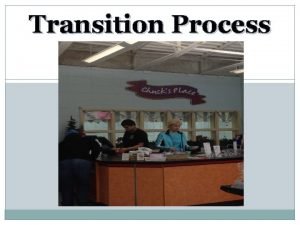The Transition from Elementary School to Middle School





















- Slides: 21

The Transition from Elementary School to Middle School Kelly Jackson Natoscha Mc. Kinnon Rebecca Wilson Johns Hopkins University October 18, 2006 Jackson, Mc. Kinnon, and Wilson (2006)

WELCOME! • Please make a nametag for yourself. • Please take an orange dot and rate your level of anxiety (high, medium, low or somewhere in between) about the middle school transition. • Child care is provided in Room 400. • Spanish-speaking presentation tomorrow night at 7 pm. Jackson, Mc. Kinnon, and Wilson (2006)

Today’s Agenda • • • Anxiety Level Pre-Assessment Introduction Goals/Objectives Icebreaker/Energizer Content: – – Procedural, Academic & Social/Emotional Concerns What Parents Can Do School’s Role Transitional Activities • Role Plays • Evaluation • Anxiety Level Post-Assessment Jackson, Mc. Kinnon, and Wilson (2006)

Goals/Objectives • Reduce your level of anxiety about the middle school transition • Give you information, tools and resources to make the transition successful • Inform you about transition activities Jackson, Mc. Kinnon, and Wilson (2006)

Icebreaker/Energizer • Independently read and rate the questions • Please split into four groups of 2 -3 • Discuss and list any additional anxieties or concerns about your child’s transition to middle school • Share anxieties and concerns with group Jackson, Mc. Kinnon, and Wilson (2006)

The Transition to Middle School • It is normal for your child to be nervous about starting middle school. • It is also perfectly normal for you to be nervous about your child’s transition to middle school. • “The transition to middle school may be one of the toughest transitions during childhood, for both parents and kids” (Brown, 2004). Jackson, Mc. Kinnon, and Wilson (2006)

Procedural Concerns • • Getting lost or finding classes Finding and opening the locker Finding the bathroom Not knowing the school rules Carrying around all those books Going from class to class without being late Bringing the right materials to the right class at the right time • Traveling longer distances to school • Eating in a larger cafeteria (Brown, 2004; Elias, 2001) Jackson, Mc. Kinnon, and Wilson (2006)

Procedural Concerns: What You Can Do • Buy a combination lock before school and have your child spend time trying to open the lock. • Go to the school two or three days before school starts and get a copy of your child’s schedule. Take a few minutes to walk from room to room with your child. • Don’t buy backpacks that can store 50 lbs. of materials. Smaller backpacks allow for better organization. (The elementary to middle school transition: Five helpful hints for parents, n. d. ) Jackson, Mc. Kinnon, and Wilson (2006)

Academic Concerns • • • Getting good grades Competition for grades Having more than one teacher More homework More long-term projects Work that is more challenging and requires more effort • Expectations of teachers in different subject areas • Basic tasks such as studying, taking notes, and taking Jackson, Mc. Kinnon, tests and Wilson (2006)

Academic Concerns: What You Can Do • • Be the example … Show the importance of education Ask your child about their day Set aside a quiet space and time for your child to study/complete homework Balance school work and play time Encourage reading Assist your child with their homework and/or check their homework daily Set high but reachable expectations for your child ENCOURAGEMENT! (Ford-Coabley, Crenshaw, Del. Aunter & Isaacs, 2006) Jackson, Mc. Kinnon, and Wilson (2006)

Social/Emotional Concerns • Bullies and/or being teased • Making new friends/Finding and connecting with a peer group • Feeling stupid compared to other kids • Success in sports • Popularity • Being embarrassed by parents in front of other kids • Puberty (pimples, body changes) • Changing before and after P. E. in front of other kids • Having girlfriends and boyfriends • Having someone to sit with at lunch • Pressure to smoke, drink alcohol, or take drugs (Brown, 2004; Elias, 2001) Jackson, Mc. Kinnon, and Wilson (2006)

Social/Emotional Concerns: What You Can Do • • • Increase your knowledge of adolescent development Be upbeat about what lies ahead Recognize their fears Offer support Hold your child accountable Give your child the opportunity to make decisions on his/her own Pick your battles Give them tools they need to succeed Allow them the freedom to make mistakes (The elementary to middle school transition: Five helpful hints for parents, n. d. ; Dean, n. d. ) Jackson, Mc. Kinnon, and Wilson (2006)

What Parent’s Can Do at SCHOOL • Maintain a good working relationship with your child’s teachers • Visit the school • Know and understand school rules • Attend meetings (PTA, conferences, etc. ) and child’s activities • Make sure your child attends school daily • Volunteer in any way you can Jackson, Mc. Kinnon, and Wilson (2006) • Make a contract with your child and/or teacher • If you have raised adolescents, be willing to share advice and information with other parents (Ford-Coabley, Crenshaw, Del. Aunter & Isaacs, 2006; The elementary to middle school transition: Five helpful hints for parents, n. d. )

What Happens if Parents Get Involved Decades of research show that when parents are involved students have … • Higher grades, test scores, and graduation rates • Better school attendance • Increased motivation • Better self-esteem • Lower rates of suspension • Decreased use of drugs and alcohol • Fewer instances of violent behavior • Greater enrollment rates in post-secondary education (Ford-Coabley, Crenshaw, Del. Aunter & Isaacs, 2006) Jackson, Mc. Kinnon, and Wilson (2006)

School’s Role • Adolescents making the middle school transition need a combination of skill training and socialemotional learning (Elias, 2001) • The school provides experiences that meet essential needs in these four areas: – – Contributions (Service learning) Belonging (Peer groups, positive relationships, safe) Talents (Academic and non-academic) Life Skills (Learning about feelings, goal-setting, group work, problem solving and resilience) (Elias, 2001) Jackson, Mc. Kinnon, and Wilson (2006)

School’s Transition Program • Helps students form a realistic expectation of what middle school will be like • Provides a positive and successful first impression • Insures a successful introduction to the middle school experience (Lorain, n. d. ) Jackson, Mc. Kinnon, and Wilson (2006)

Transition Activities • Curriculum articulation • Guidance counselors visit elementary schools • Letters sent home welcoming students and families, and inviting to school activities • Parent Teacher Association (PTA) members call each new family welcoming them to school • Mentor/buddy program • Programs new to entering students will be highlighted Jackson, Mc. Kinnon, and during student visitations Wilson (2006) • Student orientation • Open house before the first day of school • Back-to-school night • School handbook • Monthly newsletters sent home to parents • Individual and group counseling • Classroom guidance lessons • Parent workshops and groups (Schumacher, 1998)

Role Play • Please break into 3 groups of 3 -4 people. • Each group will receive a role play scenario. • Please discuss and role play within your group how you would address your child’s middle school anxiety/concern. • Share your reactions with the whole group. • Have Fun! Jackson, Mc. Kinnon, and Wilson (2006)

Positive Aspects of Transition • • Choosing classes Making new friends Participating in sports Having lockers More personal and social freedom Changing classes Electives Greater academic choices (Akos & Galassi, 2004) Jackson, Mc. Kinnon, and Wilson (2006)

References Akos, P. , & Galassi, J. P. (2004, April). Middle school and high school transitions as viewed by students, parents, and teachers. ASCA: Professional School Counseling, 7(4), 212 -221. Brown, N. (2004). Middle school transition. Retrieved October 3, 2006, from the Palo Alto Medical Foundation Web site: http: //www. pamf. org/preteen/parents/middleschoo. html. Dean, L. (n. d. ). Easing your child’s transition to middle school or junior high. Retrieved October 3, 2006, from the Partnership for Learning Web site: http: //www. partnershipforlearning. org. Elias, M. J. (Winter, 2001). Middle school transition: It’s harder than you think: Making the transition to middle school successful. Retrieved October 3, 2006, from the National Association of Elementary School Principals Web site: http: //www. naesp. org/Content. Load. do? content. Id=519&action=print Ford-Coabley, M. , Crenshaw, P. , Del. Aunter, B. , & Isaacs, S. (2006). How to get involved in your child’s learning … Powerpoint presentation. Lorain, P. (n. d. ). Transition to middle school: Are swirlies for real? Retrieved October 3, 2006, from the National Education Association Web site: http: //www. nea. org/teachexperience/msk 030408. html? mode=print Schumacher, D. (1998, June). The transition to middle school. Champaign, IL: ERIC Clearinghouse on Elementary and Early Childhood Education. (ERIC Document Reproduction Service No. ED 422119) The elementary to middle school transition: Five helpful hints for parents. Retrieved October 3, 2006, Jackson, Mc. Kinnon, and from the National Middle School Association Web site: http: //www. nmsa. org/Publications/Web. Exclusive/Helpful Hints/tabid/649/Default. aspx Wilson (2006)

Wrap-Up • • • Questions? Please complete the evaluation. Please use a blue dot to indicate your level of anxiety after this workshop. Please drop your evaluation in the box. Please pick up an informational packet and brochures. Thank you for attending our workshop! Jackson, Mc. Kinnon, and Wilson (2006)
 Elementary and middle school mathematics 10th edition
Elementary and middle school mathematics 10th edition Dpscd clever
Dpscd clever Primary school japanese elementary school uniform
Primary school japanese elementary school uniform Hình ảnh bộ gõ cơ thể búng tay
Hình ảnh bộ gõ cơ thể búng tay Slidetodoc
Slidetodoc Bổ thể
Bổ thể Tỉ lệ cơ thể trẻ em
Tỉ lệ cơ thể trẻ em Chó sói
Chó sói Tư thế worm breton là gì
Tư thế worm breton là gì Bài hát chúa yêu trần thế alleluia
Bài hát chúa yêu trần thế alleluia Các môn thể thao bắt đầu bằng tiếng chạy
Các môn thể thao bắt đầu bằng tiếng chạy Thế nào là hệ số cao nhất
Thế nào là hệ số cao nhất Các châu lục và đại dương trên thế giới
Các châu lục và đại dương trên thế giới Công thức tính độ biến thiên đông lượng
Công thức tính độ biến thiên đông lượng Trời xanh đây là của chúng ta thể thơ
Trời xanh đây là của chúng ta thể thơ Mật thư anh em như thể tay chân
Mật thư anh em như thể tay chân 101012 bằng
101012 bằng độ dài liên kết
độ dài liên kết Các châu lục và đại dương trên thế giới
Các châu lục và đại dương trên thế giới Thơ thất ngôn tứ tuyệt đường luật
Thơ thất ngôn tứ tuyệt đường luật Quá trình desamine hóa có thể tạo ra
Quá trình desamine hóa có thể tạo ra Một số thể thơ truyền thống
Một số thể thơ truyền thống









































